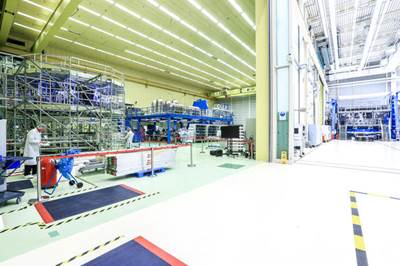Airbus ships fourth European Service Module for Artemis IV
Composites-intensive ESMs gives the Orion spacecraft power, propulsion and life support but also provide a vital gateway for the first lunar space station, Gateway.
Source |
The fourth European Service Module (ESM-4) is ready to leave ’ facilities in Bremen, Germany, and be shipped to NASA’s Kennedy Space Center in Florida. On arrival it will be tested and integrated with the Orion Crew Module ready for the next stage of NASA’s Artemis program.
Built by Airbus under contract to the European Space Agency (ESA), ESM-4 will be a vital part of the Artemis IV mission which envisages astronauts going to live and work in humanity’s first lunar space station, Gateway, which will enable new opportunities for science and preparation for human missions to Mars. Each ESM’s primary structure is highly composites-intensive.
 European Service Module (ESM). Source | Airbus
European Service Module (ESM). Source | AirbusThe lunar Gateway is to be the first international space station around the Moon and will support the most distant human space missions ever attempted. Source | ESA
“Delivering the fourth ESM takes us one step closer to a new space era with a lunar space station and increased opportunities for deep space scientific research,” says Ralf Zimmerman, head of space exploration at Airbus. “Europe’s role, through ESA, is crucial in this pioneering NASA-led program.”
ESM-4 will play a key role as the Artemis IV mission is due to deliver the International Habitation Module (Lunar I-Hab) of the Lunar Gateway space station. This state-of-the-art hardware is developed by Airbus Defence and Space and its subcontractors across Europe.
The ESM modules provide engines, power, thermal control and supply astronauts with water and oxygen. The ESM is installed underneath the crew module — together they form the Orion spacecraft. Thales Alenia Space Italia provides the thermal control system to keep the Orion crew modules between 18-24°C by radiating excess heat out of the ship but also keeping the cold at bay.
The four solar arrays on Orion generate 11.2 kilowatts of electricity, enough to power two four-person households on Earth. Only about 10% of the power is needed for the ESM, with the remaining 90% going to the batteries and equipment in the crew module. The Artemis I mission showed the solar panels were able to produce a little more power than expected and this additional energy will be of use as the Artemis program evolves.
The energy stored in the batteries of the Crew Module is key as it ensures that the Orion spacecraft has power even when the Sun is obscured. The batteries also provide power for a safe return when the ESM separates from the crew module at the end of the mission. Moreover, to enable astronauts to concentrate on important tasks, the electronics onboard the ESM, controlled by the Crew Module, provide a very high level of autonomy, such as temperature regulation and solar wing rotation to track the Sun.
Orion has 33 engines onboard the ESM to provide thrust and maneuvering capabilities. The main engine, a repurposed Space Shuttle orbital maneuvering system engine (OMS-E) provided by NASA, generates 26.5 kilonewtons of thrust. This provides enough force to escape Earth’s gravitational field and perform the translunar injection burn, and to get into the Moon’s orbit. Eight auxiliary thrusters act as back-ups to the OMS-E and for orbital corrections. There are also 24 smaller engines for attitude control in space, enabling the spacecraft to rotate or change its angle during docking manoeuvres.
Related Content
Combining multifunctional thermoplastic composites, additive manufacturing for next-gen airframe structures
The DOMMINIO project combines AFP with 3D printed gyroid cores, embedded SHM sensors and smart materials for induction-driven disassembly of parts at end of life.
Read MoreDevelopment of a composite liquid hydrogen tank for commercial aircraft
Netherlands consortium advances cryogenic composites testing, tank designs and manufacturing including AFP, hybrid winding, welding of tank components and integrated SHM and H2 sensors for demonstrators in 2025.
Read MoreLow-cost, efficient CFRP anisogrid lattice structures
CIRA uses patented parallel winding, dry fiber, silicone tooling and resin infusion to cut labor for lightweight, heavily loaded space applications.
Read MoreThe next-generation single-aisle: Implications for the composites industry
While the world continues to wait for new single-aisle program announcements from Airbus and Boeing, it’s clear composites will play a role in their fabrication. But in what ways, and what capacity?
Read MoreRead Next
Airbus-built European Service Module is ready for launch with Orion spacecraft
The European Space Module (ESM) will power NASA’s Orion spacecraft to and from its lunar orbit as part of the Artemis missions, featuring a web assembly of carbon fiber sheets and deployable CFRP rigid panels.
Read MoreAirbus ESM integration underway for future Artemis moon missions
More than 22,000 elements are begin integrated in parallel in Airbus’ Bremen cleanrooms for ESMs 3, 4 and 5, mission-critical structures for the Orion spacecraft.
Read MoreCeramic matrix composites: Faster, cheaper, higher temperature
New players proliferate, increasing CMC materials and manufacturing capacity, novel processes and automation to meet demand for higher part volumes and performance.
Read More












